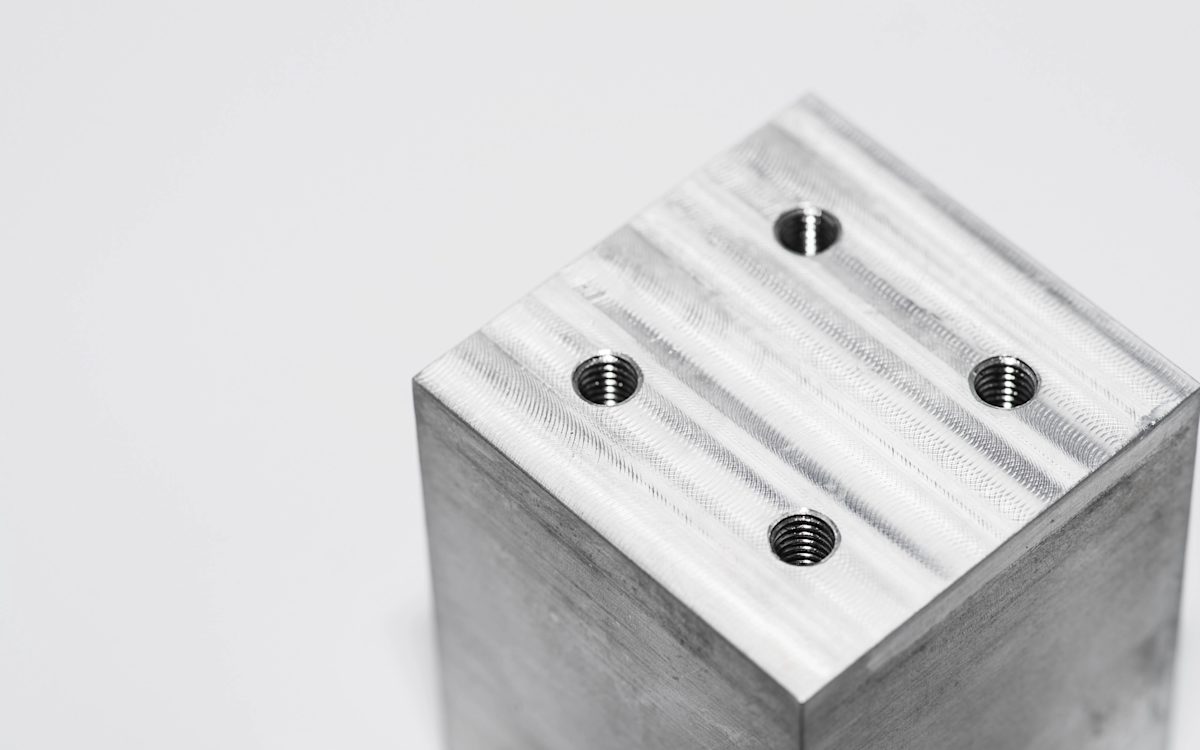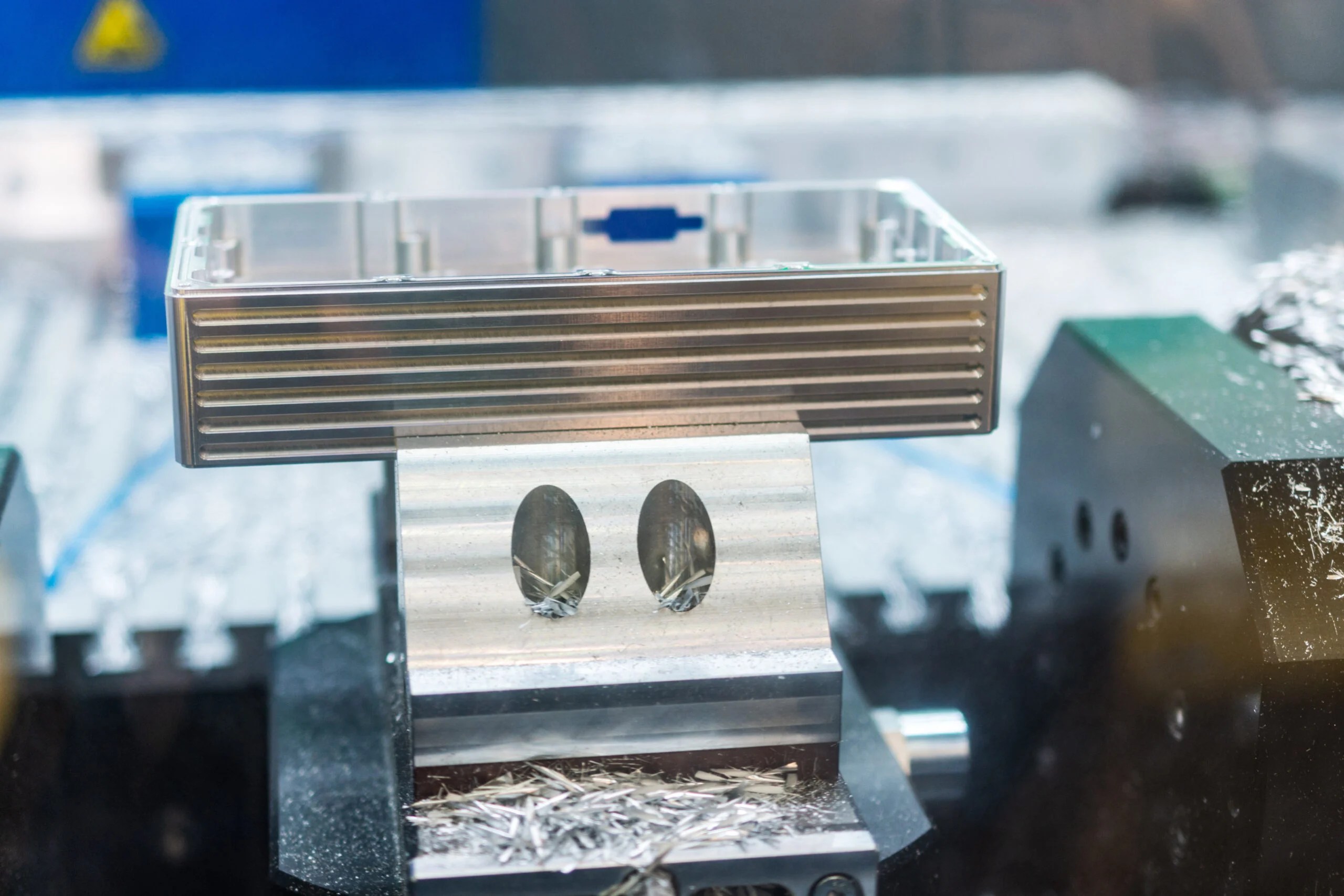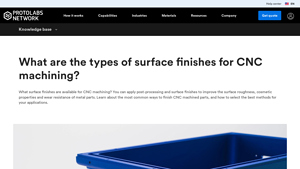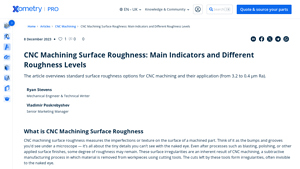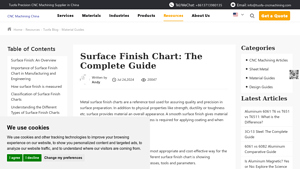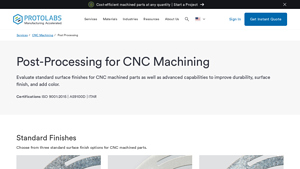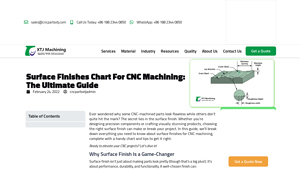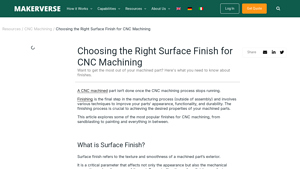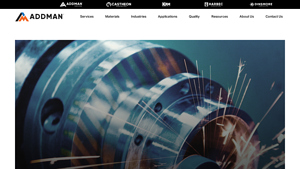Cnc Surface Finish Guide: Type, Cost, Top List…
Introduction: Navigating the Global Market for cnc surface finish
In today’s competitive landscape, navigating the global market for CNC surface finishes presents a significant challenge for international B2B buyers. With varying standards and expectations across regions—including Africa, South America, the Middle East, and Europe—sourcing the right CNC surface finish can impact both product performance and aesthetic appeal. This guide delves into the diverse types of CNC surface finishes available, such as anodizing, bead blasting, and powder coating, along with their specific applications in various industries. By understanding the technical nuances of each finish, buyers can make informed decisions that align with their operational needs.
Moreover, we will address critical factors such as supplier vetting, cost implications, and the influence of surface roughness on product functionality. As the demand for high-quality machined parts increases, the importance of selecting the appropriate surface finish cannot be overstated. This comprehensive resource is designed to empower B2B buyers with actionable insights, enabling them to navigate complexities and capitalize on opportunities in the global market. By leveraging the information in this guide, businesses can enhance their sourcing strategies, ensuring they meet both quality standards and customer expectations while optimizing their supply chains.
Understanding cnc surface finish Types and Variations
| Type Name | Key Distinguishing Features | Primary B2B Applications | Brief Pros & Cons for Buyers |
|---|---|---|---|
| As Machined | Standard finish with visible tool marks; roughness of 3.2 μm Ra. | General tooling, brackets, automotive parts. | Pros: Cost-effective, tight tolerances. Cons: Visible imperfections. |
| Bead Blasting | Matte or satin finish achieved by bombarding with glass beads. | Aesthetic parts, decorative elements, housings. | Pros: Uniform appearance, low-cost. Cons: May alter critical dimensions. |
| Anodizing Type II | Corrosion-resistant ceramic layer, available in colors. | Aerospace, automotive, consumer electronics. | Pros: Enhanced durability, aesthetic options. Cons: Limited to aluminum and titanium. |
| Anodizing Type III | Harder, thicker ceramic layer for superior wear resistance. | High-stress applications, military components. | Pros: Exceptional durability, corrosion resistance. Cons: Higher production cost. |
| Powder Coating | Thick, impact-resistant finish with a wide color range. | Outdoor furniture, automotive parts, industrial tools. | Pros: Excellent protection, versatile aesthetics. Cons: Longer curing times. |
What Are the Key Characteristics of As Machined Surface Finish?
The as-machined surface finish is the default state of CNC machined parts, characterized by visible tool marks and a surface roughness of approximately 3.2 μm Ra. This finish is suitable for applications where cost-effectiveness is a priority and minor imperfections are acceptable. B2B buyers should consider this option for general tooling and structural components where tight tolerances are essential but aesthetic qualities are less critical.
How Does Bead Blasting Enhance Surface Appearance?
Bead blasting provides a uniform matte or satin finish by using small glass beads to smooth out the surface of machined parts. This method is primarily aesthetic, making it ideal for decorative elements and housings. Buyers should note that while bead blasting improves appearance, it can affect critical dimensions, so it’s essential to communicate specific requirements to the manufacturer to avoid unintended consequences.
What Are the Benefits of Anodizing Type II for Metal Parts?
Anodizing Type II offers a corrosion-resistant ceramic layer that enhances the durability and aesthetic appeal of aluminum and titanium parts. This finish can be dyed in various colors, making it popular in industries such as aerospace and consumer electronics. When purchasing, buyers should ensure compatibility with their materials and consider the balance between aesthetic preferences and functional requirements.
Why Choose Anodizing Type III for High-Stress Applications?
Anodizing Type III, or hardcoat anodizing, creates a thicker and harder protective layer, significantly improving wear resistance. This finish is ideal for high-stress applications, including military and aerospace components, where durability is paramount. Buyers should be prepared for higher production costs but can expect superior performance in demanding environments.
What Makes Powder Coating a Versatile Finish?
Powder coating is a robust surface finishing technique that provides a thick, impact-resistant layer with a wide range of color options. It is commonly used in outdoor applications and automotive parts, where protection against environmental factors is crucial. Buyers should consider the longer curing times associated with powder coating and assess whether the enhanced durability justifies the wait in their production timelines.
Key Industrial Applications of cnc surface finish
| Industry/Sector | Specific Application of CNC Surface Finish | Value/Benefit for the Business | Key Sourcing Considerations for this Application |
|---|---|---|---|
| Aerospace | Engine components and structural parts | Enhanced durability and weight reduction | Compliance with stringent aerospace standards; material certifications |
| Automotive | Precision engine blocks and transmission parts | Improved performance and reduced friction | Tolerance requirements; surface roughness specifications |
| Medical Devices | Surgical instruments and implants | Increased biocompatibility and ease of cleaning | Regulatory compliance (ISO, FDA); material traceability |
| Oil & Gas | Valve bodies and pump components | Corrosion resistance and operational reliability | Material specifications; environmental resistance needs |
| Consumer Electronics | Housings for electronic devices | Aesthetic appeal and improved heat dissipation | Design specifications; color and finish options |
How is CNC Surface Finish Applied in Aerospace?
In the aerospace sector, CNC surface finishing is critical for engine components and structural parts, which must withstand extreme conditions. The application of surface finishes like anodizing or polishing enhances durability while reducing weight, contributing to fuel efficiency. Buyers in this industry must ensure compliance with stringent aerospace standards and obtain material certifications to guarantee performance and safety.
What Role Does CNC Surface Finish Play in Automotive Manufacturing?
In automotive manufacturing, precision engine blocks and transmission parts benefit from CNC surface finishes that improve performance by reducing friction and wear. Achieving specific surface roughness levels is essential for optimal operation, especially in high-stress scenarios. B2B buyers should focus on tolerance requirements and surface finish specifications to ensure parts meet the necessary standards for reliability and efficiency.
Why is CNC Surface Finish Important for Medical Devices?
For medical devices, CNC surface finishing is crucial in producing surgical instruments and implants that require high levels of biocompatibility and ease of cleaning. Surface finishes can prevent bacterial growth and enhance the safety of these products. Buyers must navigate regulatory compliance, including ISO and FDA standards, and ensure material traceability to maintain quality and safety in medical applications.
How Does CNC Surface Finish Enhance Oil & Gas Equipment?
In the oil and gas industry, CNC surface finishing is applied to valve bodies and pump components to enhance corrosion resistance and operational reliability. Given the harsh environments these parts are exposed to, achieving the right surface finish is vital for longevity. Buyers should prioritize material specifications and environmental resistance needs to ensure that finished components can withstand the rigors of their applications.
What Benefits Does CNC Surface Finish Provide in Consumer Electronics?
For consumer electronics, CNC surface finishing is used to create housings that not only look appealing but also improve heat dissipation. Finishes like powder coating offer both aesthetic appeal and functional benefits, which are essential in a competitive market. Buyers should consider design specifications, as well as available color and finish options, to align with branding and consumer expectations.
3 Common User Pain Points for ‘cnc surface finish’ & Their Solutions
Scenario 1: Inconsistent Surface Finishes Leading to Product Rejections
The Problem: In the competitive landscape of CNC machining, a common pain point for B2B buyers is the inconsistency in surface finishes. Buyers often encounter parts that do not meet the specified roughness levels, leading to rejections by quality control departments. This inconsistency can stem from various factors, including variations in the machining process, improper finishing techniques, or inadequate quality checks. Such rejections not only delay production timelines but also increase costs due to wasted materials and labor, ultimately affecting client relationships and project profitability.
The Solution: To mitigate this issue, it is crucial for buyers to establish clear communication with their CNC machining suppliers regarding surface finish requirements. When placing an order, provide detailed specifications, including the desired surface roughness (Ra) level and any relevant application considerations. Additionally, implementing a robust quality assurance process that includes regular inspections and testing of surface finishes can help catch inconsistencies early. Buyers should also consider working with suppliers who offer advanced finishing techniques such as bead blasting or anodizing, which can provide more uniform results. Finally, leveraging local sourcing options can enhance collaboration and lead to faster resolution of any surface finish discrepancies.
Scenario 2: High Costs Associated with Complex Surface Finishing Requirements
The Problem: Many B2B buyers find themselves facing unexpectedly high costs when it comes to achieving specific surface finishes for their CNC machined parts. Complex finishes, such as hard anodizing or custom powder coating, may require additional processing steps, specialized equipment, and longer lead times. This can result in significant price increases that were not anticipated during the initial budgeting phase. Buyers may struggle to justify these costs, especially when working on tight margins or fixed-price contracts.
The Solution: To manage and potentially reduce costs associated with complex surface finishing, buyers should prioritize thorough upfront planning. Engage in discussions with suppliers early in the design process to explore the feasibility of various finishing options and their associated costs. Consider requesting multiple quotes for different surface finishing techniques to identify the most cost-effective solution. Additionally, standardizing surface finish requirements across similar parts can lead to economies of scale, reducing overall costs. Buyers can also evaluate the necessity of specific finishes for their application—sometimes, a simpler finish may suffice and significantly lower expenses without compromising functionality.
Scenario 3: Limited Knowledge of Surface Finishing Options
The Problem: B2B buyers often encounter challenges due to a lack of knowledge regarding the various surface finishing options available for CNC machined parts. This ignorance can lead to poor decision-making when selecting finishes that align with their product requirements. For instance, a buyer may choose a surface finish that enhances aesthetic appeal but compromises wear resistance or functionality, resulting in product failures and increased warranty claims. This scenario is particularly common among companies new to CNC machining or those expanding into new markets.
The Solution: To overcome this knowledge gap, buyers should invest time in understanding the different types of surface finishes and their specific benefits. Utilizing resources such as technical articles, webinars, or consulting with industry experts can provide valuable insights into which finishes are best suited for various applications. Furthermore, establishing a collaborative relationship with suppliers can serve as an educational resource; suppliers can offer recommendations based on their expertise and experience. Buyers should also consider creating a comprehensive guide for their team that outlines the characteristics and applications of various surface finishes. This proactive approach will empower teams to make informed decisions and select appropriate finishes that enhance both performance and aesthetics, ultimately reducing the risk of costly mistakes.
Strategic Material Selection Guide for cnc surface finish
What Are the Key Materials for CNC Surface Finishing?
When selecting materials for CNC surface finishing, it is crucial to consider their properties, advantages, and limitations. This analysis will focus on four common materials: Aluminum, Stainless Steel, Brass, and Plastic. Each material has unique characteristics that influence its suitability for specific applications and surface finishing processes.
How Does Aluminum Perform in CNC Surface Finishing?
Aluminum is widely used in CNC machining due to its lightweight nature and excellent corrosion resistance. It has a high strength-to-weight ratio, making it ideal for applications in the aerospace and automotive industries. Aluminum can withstand moderate temperatures and pressures, typically up to 150°C (302°F).
Pros: Aluminum is relatively easy to machine and can achieve fine surface finishes. It is also cost-effective, especially for large production runs.
Cons: While it offers good durability, aluminum can be less resistant to wear compared to harder metals. It may also require additional surface treatments, such as anodizing, to enhance its performance.
Impact on Application: Aluminum is compatible with various media, making it suitable for components exposed to moisture and chemicals.
Considerations for International Buyers: Compliance with standards like ASTM B580 for anodized aluminum is essential. Buyers from regions like Brazil and Saudi Arabia should be aware of local regulations regarding aluminum usage in construction and manufacturing.
What Are the Benefits of Using Stainless Steel?
Stainless steel is renowned for its exceptional corrosion resistance and durability, making it a preferred choice for many industrial applications. It can withstand high temperatures and pressures, withstanding up to 600°C (1112°F) depending on the grade.
Pros: Stainless steel offers excellent mechanical properties and is highly resistant to oxidation and corrosion. It is suitable for applications in food processing, medical devices, and marine environments.
Cons: The machining of stainless steel can be more complex and costly due to its toughness. It may require specialized tools and longer machining times.
Impact on Application: Stainless steel is compatible with a wide range of media, including acidic and alkaline substances, making it ideal for harsh environments.
Considerations for International Buyers: Compliance with standards such as ASTM A240 is crucial. Buyers in Europe and the Middle East should consider certifications for food-grade stainless steel when applicable.
Why Choose Brass for CNC Surface Finishing?
Brass, an alloy of copper and zinc, is favored for its excellent machinability and aesthetic appeal. It has good corrosion resistance, particularly in low-stress applications, and can handle temperatures up to 300°C (572°F).
Pros: Brass is easy to machine and can achieve high-quality surface finishes. It is often used in decorative applications due to its attractive appearance.
Cons: Brass is less durable than stainless steel and may not be suitable for high-stress applications. Its corrosion resistance is also lower in marine environments.
Impact on Application: Brass is commonly used in plumbing, electrical connectors, and decorative hardware, where aesthetics and ease of machining are priorities.
Considerations for International Buyers: Compliance with standards like ASTM B36 is important. Buyers should also be aware of local preferences for brass in decorative applications, especially in regions like South America.
What Role Do Plastics Play in CNC Surface Finishing?
Plastics, such as ABS and polycarbonate, are increasingly used in CNC machining for their versatility and low weight. They can withstand moderate temperatures, typically up to 80°C (176°F), depending on the type.
Pros: Plastics are lightweight, corrosion-resistant, and can be produced at a lower cost than metals. They are also easier to machine and can achieve smooth finishes.
Cons: Plastics may not be suitable for high-stress applications and can degrade under UV exposure or extreme temperatures.
Impact on Application: Plastics are ideal for consumer products, automotive parts, and electronic housings, where weight savings and corrosion resistance are critical.
Considerations for International Buyers: Compliance with standards such as ISO 1043 for plastic materials is essential. Buyers in Africa and the Middle East should consider local regulations on plastic usage in consumer products.
Summary Table of Material Selection for CNC Surface Finishing
| Material | Typical Use Case for CNC Surface Finish | Key Advantage | Key Disadvantage/Limitation | Relative Cost (Low/Med/High) |
|---|---|---|---|---|
| Aluminum | Aerospace components, automotive parts | Lightweight and corrosion-resistant | Less wear resistance than metals | Medium |
| Stainless Steel | Food processing, medical devices | Exceptional durability and corrosion resistance | Complex machining process | High |
| Brass | Plumbing fixtures, decorative hardware | Excellent machinability and aesthetics | Lower durability in high-stress applications | Medium |
| Plastic | Consumer products, electronic housings | Lightweight and cost-effective | Not suitable for high-stress applications | Low |
This strategic material selection guide aims to assist international B2B buyers in making informed decisions regarding CNC surface finishing materials, ensuring compliance with local standards and suitability for specific applications.
In-depth Look: Manufacturing Processes and Quality Assurance for cnc surface finish
What Are the Main Stages in CNC Surface Finish Manufacturing Processes?
CNC surface finishing is a critical step in the production of precision parts, enhancing both aesthetics and functionality. The manufacturing process typically involves several stages: material preparation, forming, assembly, and finishing. Each of these stages is integral to achieving the desired surface quality and meeting specific application requirements.
How Is Material Prepared for CNC Machining?
Material preparation is the first step in the CNC machining process. This involves selecting the appropriate raw materials based on the end-use requirements. For CNC surface finish applications, metals such as aluminum, titanium, and various alloys are commonly used due to their favorable machining characteristics and surface finish capabilities.
Once the material is selected, it is cut to size and undergoes initial machining processes. This stage may also include heat treatment or other preparatory processes to enhance the material properties, ensuring it is suited for further machining. Proper material preparation is essential, as it sets the foundation for the quality of the final surface finish.
What Techniques Are Used in Forming CNC Parts?
The forming stage is where CNC machining truly begins. Utilizing CNC milling, turning, or a combination of these techniques, manufacturers remove material to create the desired part geometry. During this process, precision tools are employed to achieve tight tolerances, often within ± 0.025 mm.
After the initial machining, parts typically exhibit visible tool marks and a standard surface roughness of around 3.2 μm Ra. This roughness is often acceptable for many applications; however, additional finishing processes are usually required to meet higher quality standards.
How Is Assembly Conducted in the CNC Surface Finish Process?
In many cases, parts require assembly before the final finishing processes. During assembly, components may be joined through welding, fastening, or other methods. This stage is crucial, especially when dealing with complex assemblies that require precise alignment and fit.
Ensuring dimensional accuracy during assembly is vital, as any misalignment can affect the overall surface finish and functionality of the final product. B2B buyers should inquire about the assembly techniques used by suppliers, as this can significantly impact the quality of the finished part.
What Are the Common Finishing Techniques for CNC Machined Parts?
Finishing techniques are employed to improve surface quality, aesthetics, and functional characteristics. Several methods are commonly used in CNC surface finishing, including:
-
Bead Blasting: This technique involves bombarding the surface with small glass beads to create a uniform matte finish. While it enhances appearance, it may affect dimensional tolerances, making it essential to mask critical features.
-
Anodizing (Type II and Type III): This electrochemical process forms a protective oxide layer on aluminum and titanium parts, offering corrosion and wear resistance. Type II anodizing provides good corrosion resistance, while Type III (hardcoat) offers superior durability.
-
Powder Coating: A versatile finishing option that provides a robust, protective layer with a wide range of color options. It is suitable for various metals and enhances both aesthetics and wear resistance.
-
Polishing and Smoothing: These techniques reduce surface roughness, enhancing the visual appeal and functionality of parts. However, they may involve additional material removal, affecting tolerances.
How Is Quality Assurance Implemented in CNC Surface Finish Production?
Quality assurance (QA) is paramount in the CNC surface finish production process. Adhering to international standards, such as ISO 9001, ensures that manufacturers maintain consistent quality across their operations. Additionally, industry-specific certifications (e.g., CE, API) may be required depending on the application and market.
What Are the Key QC Checkpoints in CNC Machining?
Quality control (QC) checkpoints are critical for ensuring the final product meets specifications. Common QC checkpoints include:
-
Incoming Quality Control (IQC): This involves inspecting raw materials upon receipt to ensure they meet specified standards before machining begins.
-
In-Process Quality Control (IPQC): During machining, operators conduct checks to monitor dimensions and surface roughness, ensuring that the process remains within defined tolerances.
-
Final Quality Control (FQC): After machining and finishing, a comprehensive inspection is performed to verify that the parts meet all specifications, including surface finish requirements.
What Testing Methods Are Commonly Used in CNC Quality Assurance?
Several testing methods are employed to validate the quality of CNC machined parts. These include:
-
Surface Roughness Measurement: Utilizing instruments such as profilometers, manufacturers can quantify surface roughness, ensuring it aligns with specified requirements.
-
Dimensional Inspection: Calipers, gauges, and coordinate measuring machines (CMM) are used to verify the dimensions of machined parts, ensuring they adhere to tolerances.
-
Non-Destructive Testing (NDT): Techniques such as ultrasonic testing or dye penetrant inspection may be used to identify subsurface defects without damaging the parts.
How Can B2B Buyers Verify Supplier Quality Control?
B2B buyers must take proactive steps to verify supplier quality control processes. Here are some actionable strategies:
-
Conduct Supplier Audits: Regular audits of suppliers can provide insight into their quality control practices, adherence to standards, and overall manufacturing capabilities.
-
Request Quality Reports: Suppliers should be able to provide documentation demonstrating compliance with relevant standards, including inspection reports and certifications.
-
Engage Third-Party Inspectors: Hiring independent inspectors to assess the manufacturing process and final products can add an additional layer of verification, ensuring that quality standards are met.
What Are the Quality Control Nuances for International B2B Buyers?
International B2B buyers, particularly from regions like Africa, South America, the Middle East, and Europe, should be aware of certain nuances when it comes to quality control:
-
Understanding Local Standards: Different regions may have varying standards and regulations. Buyers should familiarize themselves with both international standards and local requirements to ensure compliance.
-
Cultural Differences in Quality Expectations: Quality perceptions may vary by region. Buyers should communicate their quality expectations clearly and understand suppliers’ capabilities in meeting these expectations.
-
Logistical Considerations: Shipping and logistics can impact the quality of products. Buyers should discuss how suppliers manage transportation and handling to minimize damage during transit.
In summary, understanding the manufacturing processes and quality assurance measures associated with CNC surface finishes is crucial for B2B buyers. By being informed about these aspects, buyers can make better decisions, ensuring they partner with suppliers who can meet their quality and performance requirements.
Practical Sourcing Guide: A Step-by-Step Checklist for ‘cnc surface finish’
Introduction
Navigating the procurement of CNC surface finishes can be complex, particularly for international B2B buyers. This guide serves as a practical checklist to ensure you make informed decisions when sourcing surface finishes for your CNC machined parts. By following these steps, you can enhance product performance, aesthetic quality, and overall supplier reliability.
Step 1: Define Your Technical Specifications
Before engaging with suppliers, it is essential to clearly outline your technical requirements. This includes specifying the desired surface finish type, roughness level (e.g., Ra values), and material compatibility. A well-defined specification helps suppliers understand your needs and reduces the risk of miscommunication.
- Surface Finish Types: Consider finishes such as anodizing, bead blasting, or powder coating based on your application.
- Roughness Levels: Determine acceptable roughness levels based on the part’s functionality and performance requirements.
Step 2: Research Supplier Capabilities
Investigate potential suppliers to ensure they have the necessary expertise and technology to meet your specifications. Look for manufacturers with a proven track record in CNC surface finishing, particularly for your specific materials and finishes.
- Technical Expertise: Review their experience with similar projects and industries.
- Technology and Equipment: Assess whether they utilize modern CNC machines and finishing technologies that can achieve your required tolerances.
Step 3: Evaluate Supplier Certifications
Supplier certifications are critical indicators of quality and reliability. Check for relevant industry certifications such as ISO 9001, which demonstrates a commitment to quality management systems.
- Quality Assurance: Confirm that suppliers maintain stringent quality control processes.
- Compliance Standards: Ensure they comply with international standards relevant to your industry.
Step 4: Request Samples and Proof of Work
Before finalizing your supplier, request samples of their previous work or prototypes of your parts. This allows you to evaluate the surface finish quality, adherence to specifications, and overall craftsmanship.
- Sample Evaluation: Look for consistency in finish and dimensional accuracy.
- Real-World Application: Assess how the sample performs under conditions similar to those your parts will face.
Step 5: Assess Lead Times and Production Capacity
Understanding a supplier’s lead times and production capabilities is vital for planning your supply chain effectively. Delays in production can impact your project timelines and costs.
- Production Scheduling: Discuss their ability to meet your deadlines, especially for bulk orders.
- Capacity Flexibility: Inquire about their capacity to scale production if your order volume increases.
Step 6: Negotiate Terms and Conditions
Once you’ve identified a suitable supplier, it’s time to discuss terms and conditions. This includes pricing, payment terms, and warranty conditions for the surface finishes.
- Transparent Pricing: Ensure that all costs are clearly outlined, including any potential additional fees for expedited services.
- Warranty and Support: Understand the warranty terms for surface finishes and what support is available in case of defects.
Step 7: Establish a Communication Plan
Effective communication is crucial throughout the procurement process. Establish a clear plan for ongoing communication with your supplier to address any issues that may arise.
- Regular Updates: Set expectations for progress updates and any necessary adjustments.
- Point of Contact: Identify a specific contact person for streamlined communication and issue resolution.
By following this checklist, you can confidently navigate the sourcing of CNC surface finishes, ensuring that you select the right supplier and achieve the quality required for your projects.
Comprehensive Cost and Pricing Analysis for cnc surface finish Sourcing
What Are the Key Cost Components in CNC Surface Finish Sourcing?
When sourcing CNC surface finishes, understanding the cost structure is crucial for effective budgeting and strategic decision-making. The primary cost components include:
-
Materials: The type of surface finish significantly affects material costs. For instance, anodizing requires specific chemicals and processes that can increase material expenses compared to simpler methods like bead blasting.
-
Labor: Labor costs can vary based on the complexity of the surface finishing process. Skilled labor is often required for specialized finishes like polishing or anodizing, which can elevate costs.
-
Manufacturing Overhead: This includes expenses related to the operation of machinery, utilities, and facility maintenance. More intricate surface finishes often require advanced machinery and longer operational hours, leading to higher overhead costs.
-
Tooling: Certain finishes may necessitate specialized tools or equipment, adding to the overall tooling costs. For example, polishing and grinding tools may need regular replacement, influencing the pricing.
-
Quality Control (QC): Ensuring that parts meet specified surface roughness and finish standards involves quality assurance processes. The costs associated with QC can rise with the complexity of the finish required.
-
Logistics: Transportation costs can impact pricing, especially for international orders. Factors such as distance, shipping methods, and customs can add to the final cost of sourcing.
-
Margin: Suppliers typically include a profit margin in their pricing, which can vary based on market conditions, competition, and supplier reputation.
How Do Volume and Customization Influence CNC Surface Finish Pricing?
Pricing for CNC surface finishes is heavily influenced by order volume and customization requirements. Higher volumes typically lead to lower per-unit costs due to economies of scale. Suppliers are often willing to negotiate better pricing for larger orders, which can be particularly advantageous for manufacturers planning long-term production runs.
Customization also plays a significant role; unique specifications or finishes may incur additional costs due to the need for specialized processes or materials. Buyers should communicate their precise needs early in the sourcing process to receive accurate quotes.
What Buyer Tips Can Enhance Cost Efficiency in CNC Surface Finishing?
To achieve cost efficiency in sourcing CNC surface finishes, buyers should consider the following tips:
-
Negotiate with Suppliers: Engage in open discussions about pricing and seek volume discounts or flexible payment terms. Building a long-term relationship with suppliers can lead to better deals over time.
-
Evaluate Total Cost of Ownership (TCO): Look beyond initial pricing to consider the TCO, including maintenance, durability, and performance of finished parts. For instance, investing in higher-quality finishes might reduce long-term replacement costs.
-
Understand Pricing Nuances for International Sourcing: Factors such as Incoterms (International Commercial Terms) can significantly affect overall costs. Familiarize yourself with terms like FOB (Free on Board) or CIF (Cost, Insurance, and Freight) to manage logistics and shipping expenses effectively.
-
Research Supplier Credentials: Verify supplier certifications and quality assurance processes. Suppliers with recognized quality standards may command higher prices but can offer better reliability and performance, justifying the investment.
What Should International Buyers Know About CNC Surface Finish Pricing?
For international buyers, especially those from regions like Africa, South America, the Middle East, and Europe, several considerations are crucial:
-
Currency Fluctuations: Be aware of currency exchange rates, as they can impact the cost of sourcing from foreign suppliers. Consider locking in prices when favorable rates are available.
-
Regulatory Compliance: Different regions may have varying regulations regarding materials and surface finishes. Ensure compliance to avoid potential penalties or delays.
-
Cultural Nuances in Negotiation: Understanding cultural differences in negotiation styles can enhance communication with suppliers, leading to better outcomes.
Disclaimer on Indicative Prices
Prices for CNC surface finishes can fluctuate based on market conditions, material availability, and supplier pricing strategies. It is advisable for buyers to conduct thorough research and obtain multiple quotes to ensure competitive pricing.
Alternatives Analysis: Comparing cnc surface finish With Other Solutions
Exploring Alternatives to CNC Surface Finishing: What Are Your Options?
When considering CNC surface finishing, it’s crucial to evaluate alternative solutions that might meet your operational and aesthetic requirements. Various methods can enhance the surface quality of machined parts, each offering unique advantages and trade-offs. This analysis will compare CNC surface finishing with bead blasting and anodizing, two prevalent methods for achieving surface refinement.
| Comparison Aspect | Cnc Surface Finish | Bead Blasting | Anodizing |
|---|---|---|---|
| Performance | High precision; tight tolerances | Good for aesthetics; limited wear resistance | Excellent corrosion and wear resistance |
| Cost | Varies based on finish type | Generally low-cost | Moderate to high, depending on type |
| Ease of Implementation | Requires specialized machinery; skilled operators needed | Relatively simple; can be done manually | Requires chemical processing; strict safety measures |
| Maintenance | Minimal; depends on part usage | Low; surface can degrade over time | Requires proper sealing to maintain effectiveness |
| Best Use Case | High-precision parts needing exact specifications | Parts where aesthetics are prioritized | Components requiring high durability and corrosion resistance |
Analyzing Bead Blasting as an Alternative to CNC Surface Finishing
Bead blasting is a mechanical process that uses small glass beads to create a uniform matte finish on machined surfaces. This method effectively removes tool marks and achieves a satisfactory aesthetic quality. However, it is primarily focused on visual improvement rather than enhancing functional properties.
Pros: Bead blasting is typically a low-cost option that can be implemented relatively quickly. It allows for a uniform finish across various materials, making it suitable for parts where aesthetics are a priority.
Cons: The process can affect critical dimensions, leading to potential issues in precision applications. Additionally, it does not offer significant protection against wear or corrosion, limiting its effectiveness for high-performance components.
Exploring Anodizing: A Robust Alternative for Surface Treatment
Anodizing is an electrochemical process that creates a protective oxide layer on aluminum and titanium parts. This method enhances corrosion resistance and wear properties while allowing for color customization, making it particularly appealing for consumer-facing products.
Pros: Anodizing provides excellent durability and can significantly extend the lifespan of components exposed to harsh environments. The aesthetic flexibility of anodizing—through color options—adds value for products that require visual appeal alongside functionality.
Cons: Anodizing can be more costly than other surface finishing methods due to the complexity of the process and the need for specialized equipment. It also requires careful handling and processing to maintain safety standards, which may complicate operations for some manufacturers.
How to Choose the Right Surface Finishing Solution for Your Needs
Selecting the most appropriate surface finishing method involves assessing your specific application requirements. If precision and tight tolerances are paramount, CNC surface finishing remains a strong choice despite its higher costs and complexity. Conversely, if aesthetics are your main concern, bead blasting may suffice at a lower price point. For applications demanding high durability and corrosion resistance, anodizing stands out as the best option, albeit at a potentially higher investment.
In conclusion, understanding the performance, cost implications, and application suitability of each method is essential for making an informed decision. By aligning your choice with your operational goals and product requirements, you can ensure optimal results in your manufacturing processes.
Essential Technical Properties and Trade Terminology for cnc surface finish
What Are the Key Technical Properties of CNC Surface Finish?
Understanding the critical specifications for CNC surface finishes is essential for B2B buyers to ensure the right choices are made for their manufacturing needs. Here are several key technical properties to consider:
1. Surface Roughness (Ra)
Surface roughness, measured in micrometers (μm), quantifies the texture of a surface. It is defined by the average deviation of the surface profile from an ideal smooth surface. Common roughness values include 3.2 μm (as machined), 1.6 μm, and 0.8 μm. For B2B buyers, selecting the appropriate Ra is crucial as it influences friction, wear, and the overall performance of machined parts. Parts with lower Ra values are typically more suitable for high-stress applications.
2. Tolerance
Tolerance refers to the allowable deviation from a specified dimension. CNC machining can achieve tight tolerances (e.g., ±0.025 mm), which is critical for parts that must fit precisely within assemblies. For buyers, understanding tolerance requirements helps in evaluating machining capabilities and ensuring that parts meet their specific functional needs, thus reducing the risk of costly rework.
3. Material Grade
The material grade indicates the specific type of metal or plastic used for machining. Different grades offer varying characteristics such as strength, corrosion resistance, and machinability. For instance, aluminum grades like 6061 or titanium alloys each have unique properties that affect performance. Buyers must specify the appropriate material grade to ensure that the final product meets durability and application requirements.
4. Finish Type
The finish type describes the post-processing applied to the machined part, such as anodizing, bead blasting, or powder coating. Each finish offers distinct benefits, including aesthetics, corrosion resistance, and wear protection. Understanding the available finish types enables buyers to select options that enhance both functionality and appearance, aligning with their project specifications.
5. Dimensional Stability
Dimensional stability refers to a part’s ability to maintain its dimensions under varying conditions (temperature, humidity, etc.). It is particularly important for precision components that operate in fluctuating environments. Buyers should prioritize materials and finishes that enhance dimensional stability to ensure long-term performance and reliability.
What Are Common Trade Terms Related to CNC Surface Finish?
Familiarity with industry terminology is vital for effective communication and negotiation in B2B transactions. Here are some essential terms you should know:
1. OEM (Original Equipment Manufacturer)
An OEM is a company that produces parts or equipment that are used in another company’s end product. Understanding OEM relationships helps buyers ensure they are sourcing parts from reputable manufacturers that meet quality standards.
2. MOQ (Minimum Order Quantity)
MOQ refers to the smallest number of units a supplier is willing to sell. This term is critical for buyers to understand their purchasing requirements and inventory management, particularly when dealing with custom CNC machined parts.
3. RFQ (Request for Quotation)
An RFQ is a document that buyers send to suppliers to obtain pricing for specific products or services. Including detailed specifications for CNC surface finishes in an RFQ ensures that suppliers can provide accurate quotes, facilitating better budgeting and planning.
4. Incoterms (International Commercial Terms)
Incoterms define the responsibilities of buyers and sellers in international shipping. Understanding these terms helps buyers mitigate risks related to shipping costs, insurance, and delivery responsibilities, ensuring smoother transactions across borders.
5. Lead Time
Lead time is the amount of time from placing an order to receiving the finished product. For B2B buyers, knowing lead times for CNC machining and surface finishing is essential for project planning and meeting deadlines.
By grasping these essential technical properties and trade terms, B2B buyers can make informed decisions that enhance their procurement processes and ultimately contribute to successful project outcomes.
Navigating Market Dynamics and Sourcing Trends in the cnc surface finish Sector
What are the Current Market Dynamics and Key Trends in the CNC Surface Finish Sector?
The CNC surface finish sector is experiencing significant growth, driven by increasing demand for precision-engineered components across various industries, including automotive, aerospace, and electronics. Globalization has opened up new markets, particularly in regions like Africa, South America, and the Middle East, where local manufacturers are seeking high-quality surface finishes to compete internationally. This trend is amplified by advancements in CNC machining technologies, enabling faster production times and improved surface quality, which are crucial for meeting the strict quality standards expected by international buyers.
Emerging B2B technologies such as automation and AI-driven quality control are reshaping sourcing strategies in the CNC surface finish industry. These technologies not only enhance precision but also reduce operational costs, allowing suppliers to offer competitive pricing. Additionally, the rise of digital platforms for sourcing CNC services is simplifying the procurement process, enabling buyers to compare quotes and specifications from multiple suppliers efficiently.
International buyers are increasingly looking for suppliers that can provide tailored surface finishing solutions, such as anodizing, powder coating, and bead blasting. The flexibility to customize finishes based on specific application requirements is becoming a key differentiator in supplier selection. As markets evolve, the emphasis on rapid prototyping and short lead times is also influencing sourcing dynamics, pushing suppliers to adopt agile manufacturing practices.
How is Sustainability and Ethical Sourcing Impacting the CNC Surface Finish Sector?
Sustainability is becoming a cornerstone of B2B sourcing strategies in the CNC surface finish sector. With growing awareness of environmental impacts, international buyers are prioritizing suppliers that demonstrate commitment to sustainable practices. This includes the use of eco-friendly materials and processes, such as water-based coatings and non-toxic surface treatments. Buyers are increasingly inclined to partner with manufacturers that can provide certifications or evidence of sustainable sourcing, which not only aids in compliance with international regulations but also enhances brand reputation.
The importance of ethical supply chains cannot be overstated, especially in regions like Africa and South America, where sourcing practices can significantly impact local communities. Companies are now expected to ensure fair labor practices and transparency throughout their supply chains. Buyers should look for suppliers who engage in ethical sourcing and can demonstrate a positive environmental and social impact, as this is becoming a critical factor in purchasing decisions.
Furthermore, the demand for ‘green’ certifications is on the rise. Certifications such as ISO 14001 for environmental management and other local eco-labels serve as indicators of a supplier’s commitment to sustainability. By collaborating with certified suppliers, international buyers can not only meet their own sustainability goals but also appeal to environmentally conscious consumers.
How has the CNC Surface Finish Sector Evolved Over Time?
The evolution of the CNC surface finish sector has been marked by advancements in manufacturing technology and changing market demands. Initially, CNC machining was primarily focused on achieving high precision in part production, with surface finishes often considered secondary. However, as industries have evolved and the demand for high-quality components has increased, surface finishing has gained prominence as a critical step in the manufacturing process.
Historically, surface finishing processes were labor-intensive and lacked the precision required for modern applications. The introduction of automated and computer-controlled surface finishing techniques has revolutionized the sector, allowing for consistent quality and efficiency. Today, buyers can select from a variety of sophisticated finishing options tailored to specific material properties and functional requirements, reflecting the industry’s adaptation to contemporary manufacturing challenges and standards.
As technology continues to advance, the CNC surface finish sector will likely see further innovations that enhance quality, reduce environmental impact, and cater to the growing expectations of international buyers.
Frequently Asked Questions (FAQs) for B2B Buyers of cnc surface finish
-
1. How do I choose the right surface finish for my CNC machined parts?
Selecting the appropriate surface finish involves understanding the application and performance requirements of your parts. Consider factors such as corrosion resistance, wear resistance, and aesthetic appeal. Common finishes like anodizing, powder coating, or bead blasting serve different purposes. Evaluate the environment in which the parts will be used and the desired surface roughness—ranging from as machined (3.2 μm Ra) to polished finishes (0.4 μm Ra). Engaging with suppliers who offer expertise in surface finishing can help you make an informed decision. -
2. What are the most common surface finishes available for CNC machining?
The most common surface finishes for CNC machined parts include: - As Machined: Standard finish with visible tool marks (3.2 μm Ra).
- Bead Blasting: Provides a matte finish, mainly for aesthetics.
- Anodizing Type II: Adds a corrosion-resistant layer for aluminum and titanium.
- Anodizing Type III: Offers enhanced wear resistance and can be dyed.
-
Powder Coating: Provides a durable, impact-resistant finish available in various colors. Choosing the right finish depends on the specific application and desired properties.
-
3. How can I assess the quality of a CNC surface finish supplier?
To assess a CNC surface finish supplier, examine their certifications, such as ISO 9001, which indicates a commitment to quality management. Request samples of their previous work to evaluate the surface finish quality and adherence to specifications. Additionally, check client testimonials and case studies to gauge their reliability and customer service. It’s also important to inquire about their capabilities in surface finishing techniques and their experience with similar projects in your industry. -
4. What are the typical minimum order quantities (MOQs) for CNC surface finish services?
Minimum order quantities (MOQs) for CNC surface finish services can vary significantly by supplier and the complexity of the parts. Generally, MOQs may range from a few units to several hundred, depending on the finishing process and material involved. For custom finishes, suppliers may require higher MOQs to justify setup and production costs. Discussing your project requirements with potential suppliers can help you understand their specific MOQ policies and find a suitable partner for your needs. -
5. What payment terms should I expect when sourcing CNC surface finish services internationally?
Payment terms for international sourcing of CNC surface finish services often include options like upfront deposits, milestone payments, or payment upon delivery. Common practices involve a 30% deposit before production and the remaining balance upon completion. Ensure you clarify these terms before finalizing agreements and consider using secure payment methods to protect your financial transactions. It’s also wise to establish clear terms regarding currency exchange rates, as they may affect the final costs. -
6. How do logistics and shipping impact the cost of CNC surface finish services?
Logistics and shipping can significantly impact the total cost of CNC surface finish services. Factors such as the distance from the supplier, shipping method, and any customs duties or tariffs must be considered. Additionally, the weight and size of the finished parts can influence shipping costs. Collaborating with suppliers who have experience in international logistics can help streamline the process and reduce unexpected expenses. Always factor in potential delays in shipping when planning your project timeline. -
7. What quality assurance measures should I expect from a CNC surface finish provider?
Reputable CNC surface finish providers typically implement rigorous quality assurance measures, including in-process inspections, final quality checks, and adherence to specified surface roughness standards. Ask about their inspection techniques, such as using profilometers to measure surface roughness and visual inspections for defects. Certifications, such as ISO or AS9100, indicate adherence to industry standards. Establishing clear quality expectations upfront will help ensure the finished parts meet your requirements. -
8. Can I customize the surface finish for my specific application needs?
Yes, many CNC surface finish suppliers offer customization options to cater to specific application needs. You can specify the desired surface finish, roughness levels, and any additional features, such as color or protective coatings. Engaging in detailed discussions with your supplier about your project requirements is crucial to achieving the desired results. Custom solutions may come with additional costs and longer lead times, so plan accordingly to meet your project deadlines.
Important Disclaimer & Terms of Use
⚠️ Important Disclaimer
The information provided in this guide, including content regarding manufacturers, technical specifications, and market analysis, is for informational and educational purposes only. It does not constitute professional procurement advice, financial advice, or legal advice.
While we have made every effort to ensure the accuracy and timeliness of the information, we are not responsible for any errors, omissions, or outdated information. Market conditions, company details, and technical standards are subject to change.
B2B buyers must conduct their own independent and thorough due diligence before making any purchasing decisions. This includes contacting suppliers directly, verifying certifications, requesting samples, and seeking professional consultation. The risk of relying on any information in this guide is borne solely by the reader.
Top 8 Cnc Surface Finish Manufacturers & Suppliers List
1. Hubs – CNC Machining Surface Finishes
Domain: hubs.com
Registered: 1998 (27 years)
Introduction: Types of surface finishes for CNC machining include: 1. As Machined: Parts come off the machine with minor visible tool marks and a standard surface roughness (Ra) of 3.2 μm. 2. Bead Blasting: Provides a matte finish with a light texture, primarily for visual improvement. 3. Anodizing Type II: Adds a corrosion-resistant ceramic layer, available for aluminum and titanium, can be dyed in various col…
2. Xometry – CNC Machining Surface Roughness Solutions
Domain: xometry.pro
Registered: 2023 (2 years)
Introduction: CNC machining surface roughness measures imperfections or texture on machined parts, influencing performance parameters like friction, noise, wear, heat generation, and adhesion. Common surface roughness levels include: 3.2 μm Ra (for parts under stress, no extra costs), 1.6 μm Ra (for slow-moving surfaces, adds ±2.5% to costs), 0.8 μm Ra (for high-stress applications, adds ±5% to costs), and 0.4 …
3. Tuofa – Precision CNC Machining Services
Domain: tuofa-cncmachining.com
Registered: 2022 (3 years)
Introduction: Tuofa Precision CNC Machining offers a variety of services including CNC Machining, CNC Turning, CNC Milling, CNC Cutting, CNC Drilling, Wire EDM Machining, 5 Axis CNC Machining, and Sheet Metal Fabrication. They work with a range of materials including metals (Aluminum, Brass, Tool Steel, Copper, Stainless Steel, Titanium, CNC Steel) and plastics (ABS, Acrylic, Delrin, HDPE, Nylon, PEEK, Polycarb…
4. Protolabs – Surface Finishes for CNC Machining
Domain: protolabs.com
Registered: 2006 (19 years)
Introduction: Surface Finishes for CNC Machining: 1. Standard Finishes:
– Edges broken (tool marks visible): Materials – Plastic, Metals; Cost – $
– Edges broken and light bead blast: Materials – Metals; Cost – $$
– Leave sharp (tool marks visible): Materials – Metals; Cost – $
Certifications: ISO 9001:2015, AS9100D, ITAR.
Capabilities: Evaluate standard surface finishes for CNC machined pa…
5. Sybridge – CNC Machined Part Finishes
Domain: sybridge.com
Registered: 2003 (22 years)
Introduction: CNC Machined Part Finishes: 1. As-Machined: – Average surface roughness: ~3.2 μm – Tight dimensional tolerances – Affordable, no post-processing – Susceptible to damage (nicking, scuffing, scratching) 2. Anodizing: – Electrochemical process for aluminum/titanium alloys – Types: Type II (decorative, 4-12 μm thick) and Type III (hardcoat, up to 125 μm thick) – Smooth, corrosion and wear-resistant – …
6. CNC Parts XTJ – Surface Finishes
Domain: cncpartsxtj.com
Registered: 2019 (6 years)
Introduction: Surface finishes for CNC machining are crucial for performance, durability, and aesthetics. Key parameters include lay, roughness (measured as Ra, Rz, Rmax), and waviness. Common finishes include: 1. As Machined: Ra 125–250 µin, suitable for non-critical surfaces in aluminum and steel. 2. Bead Blasted: Ra 32–125 µin, ideal for stainless steel and plastics for a matte look. 3. Polished: Ra 8–16 µin…
7. MakerVerse – CNC Machining Surface Finishes
Domain: makerverse.com
Registered: 2012 (13 years)
Introduction: CNC machining involves a finishing process that enhances the appearance, functionality, and durability of parts. Key factors for choosing a surface finish include functionality, material compatibility, aesthetics, cost, lead time, environmental impact, and part geometry. Common surface finishes discussed include hardening (for wear resistance), tempering (for toughness), anodizing (for corrosion r…
8. Addman Group – Anodizing Solutions
Domain: addmangroup.com
Registered: 2020 (5 years)
Introduction: Anodizing: Provides a protective coating, increases wear resistance, non-toxic, low-cost, available in various colors, but may fade over time and can corrode if not cared for. Type II anodizing offers thicker oxidation layers for better durability and wear resistance. Matte anodizing provides a subtle finish with excellent corrosion protection. Plating: Involves depositing a thin layer of metal (n…
Strategic Sourcing Conclusion and Outlook for cnc surface finish
In the competitive landscape of CNC machining, strategic sourcing of surface finishes is essential for optimizing product performance and aesthetic appeal. Understanding the various surface finish options—ranging from as-machined to anodized and powder-coated—allows B2B buyers to select finishes that align with their specific applications, enhancing durability and functionality. The choice of surface finish not only impacts the part’s performance but also influences overall project costs and timelines.
Moreover, international buyers, particularly in regions such as Africa, South America, the Middle East, and Europe, should leverage local and global suppliers to ensure they receive quality finishes that meet international standards. By fostering relationships with reliable partners, companies can streamline their procurement processes and mitigate risks associated with sourcing.
Looking ahead, the demand for high-quality CNC surface finishes is expected to grow as industries increasingly focus on precision and longevity. B2B buyers are encouraged to stay informed about advancements in surface finishing technologies and to prioritize partnerships that offer innovative solutions. By doing so, they can ensure their products not only meet but exceed market expectations, positioning themselves for success in an evolving marketplace.
